* (restored)

_____________
Jeppe Hein Water Flame (2006)
Water Flame is an installation combining two elements usually opposed to each other in a spectactular but nevertheless minimalist way: a small sprinkling fountain with a flame burning on the top. This paradoxical constellation of elements creates an effect of astonishment and wonder.
_____________
Sylvie Fleury Gold Fountain PKW (2003)
Gold porcelain, plexiglass plinth, 18 x 62 x 62 cm

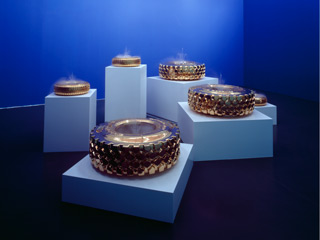
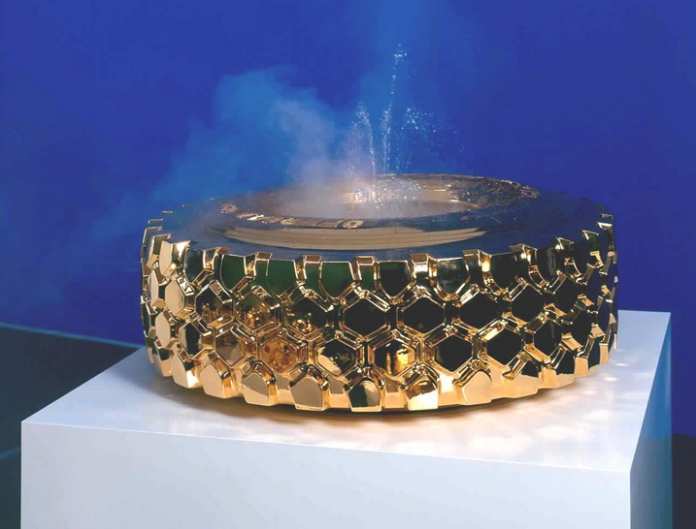
_____________
Raffaelo Romanelli Untitled (1928)
Outside of the Starbucks in the Plaza of Kansas City is a thoroughly inappropriate fountain called “Boy and Frog.” Why is this fountain inappropriate? If you can’t tell from the picture, it is a naked young boy with his frog. When turned on, the water sprays from the little boy’s peep into the frog’s mouth. It is a little boy peeing in a frog’s mouth! How is that appropriate for public viewing?! I first saw the fountain when my friend Anna came to visit me last year. We went to the Plaza and to look at all high-fashion things we couldn’t afford and be “ladies who lunch.” After lunch we went to get some coffee. That was when we saw it. A boy peeing into a frog’s mouth. We both stared for a while, trying to be sure of what we were seeing. Then I looked around for someone else who was shocked by the fountain, but nothing. People were buying their lattes and going on their way. Apparently public depictions of little boys peeing in the mouths of amphibians is okay in Missouri. It was originally sculpted by Raffaelo Romanelli and was acquired for the Plaza in Florence, Italy in 1928 by John C. Taylor, the chairman of the J.C. Nichols Company. I’m all for artistic expression and extremely opposed to censorship, but I’m struggling to get what the creative merit to this fountain is.
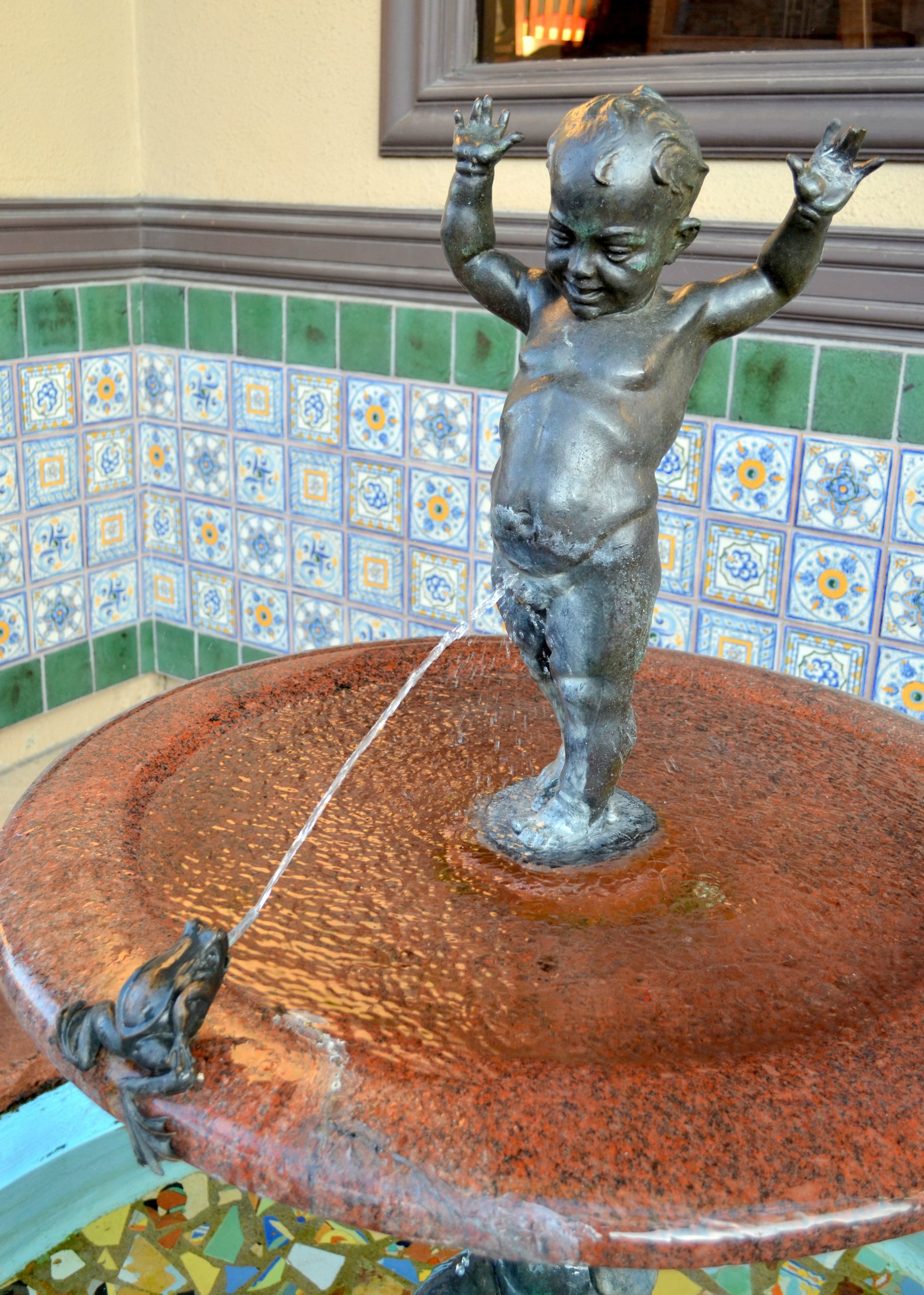
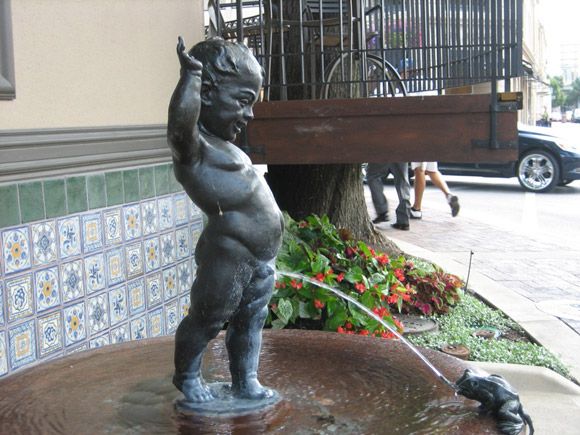
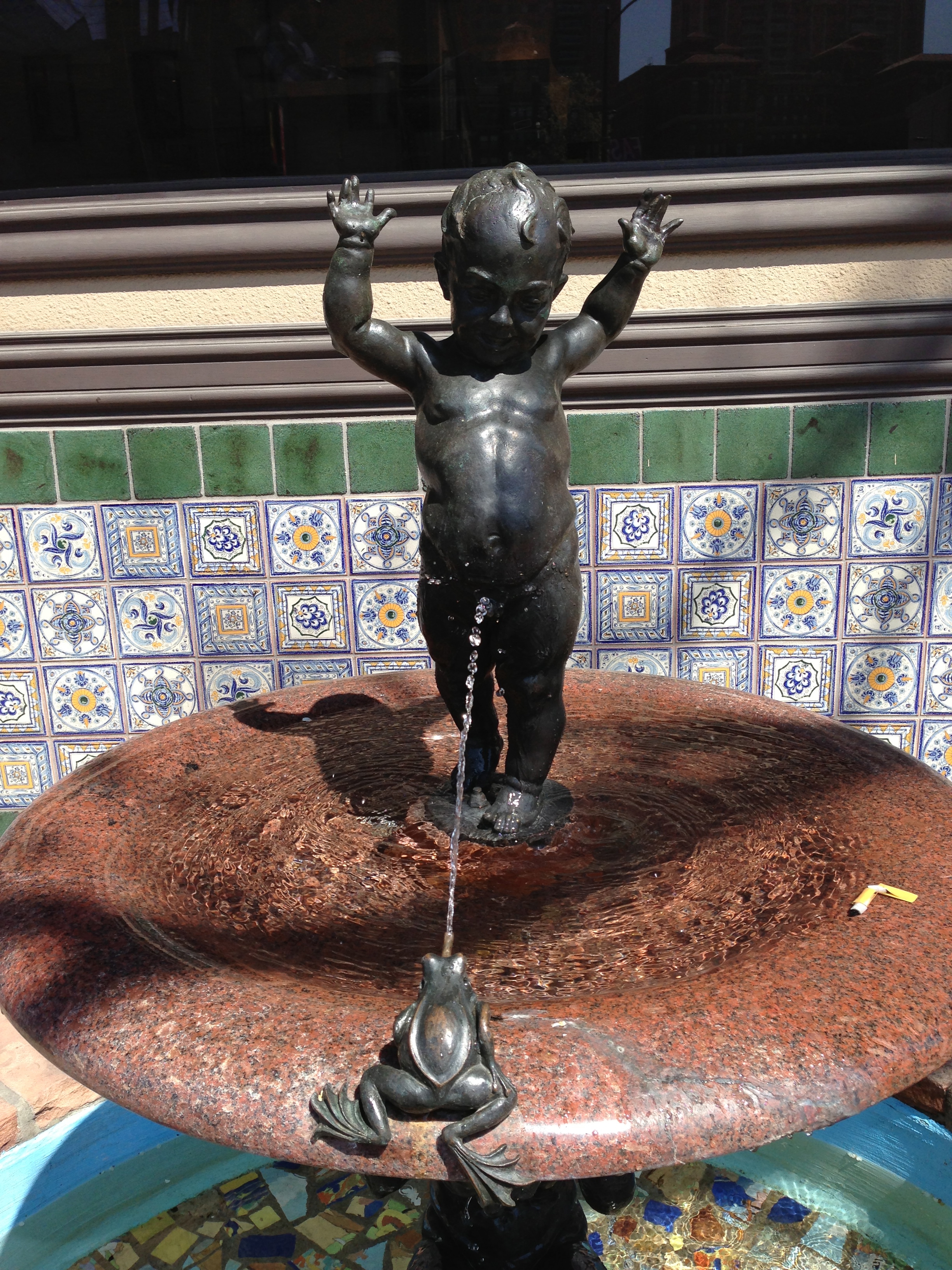
______________
Klaus Weber Sandfountain (2012)
As we move into what has been called the anthropocene age, in which we prove we can do just what we damn well please with the planet, traditional fountains are redundant. That is what makes Klaus Weber’s Sandfountain so timely. It’s a technological swansong which swaps a single water pump for some dozen sandblasting units. The sand will erode the concrete and you can already see the disconcerting way it shifts and cascades.
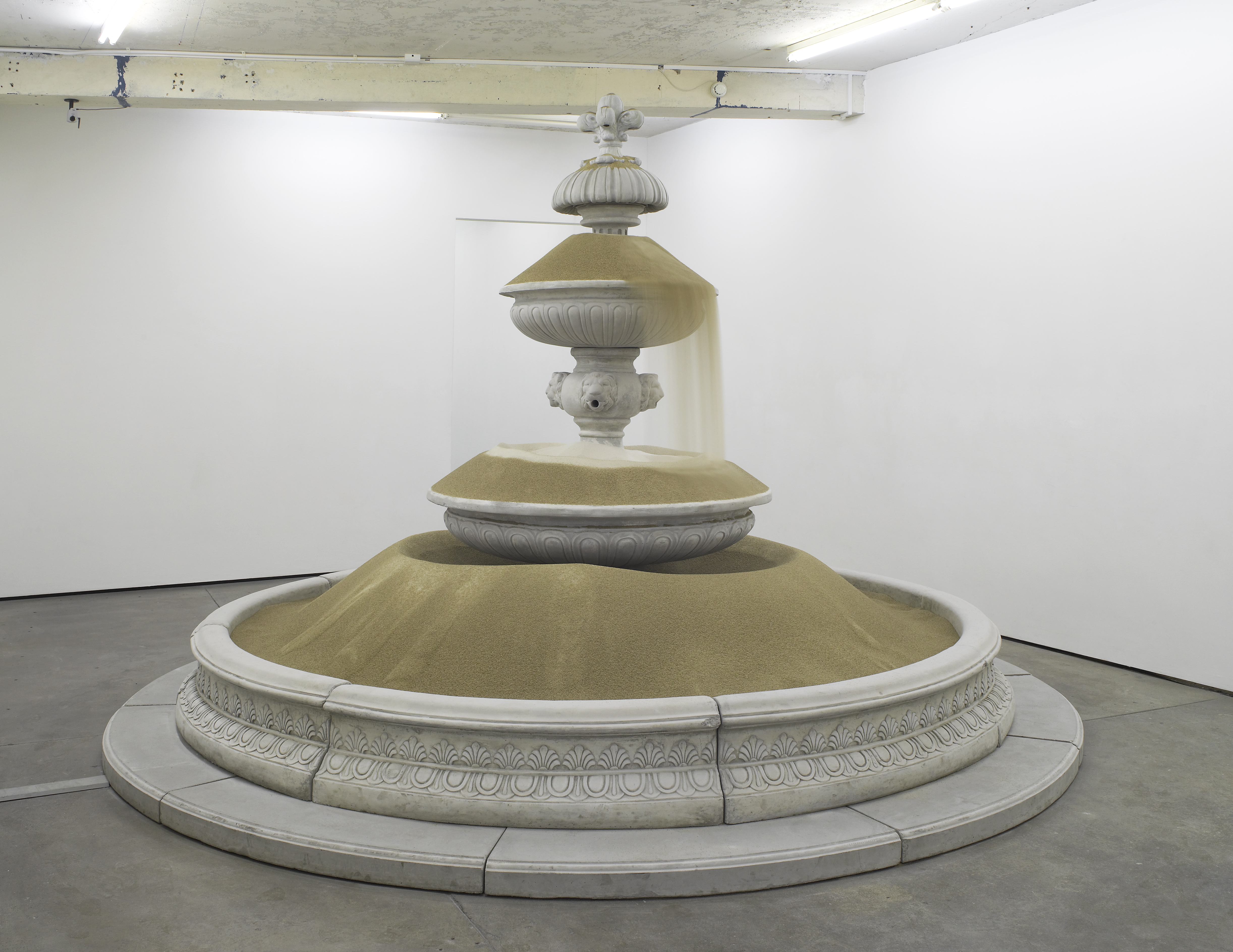
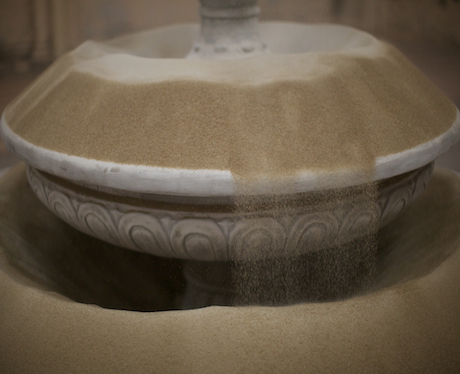
_____________
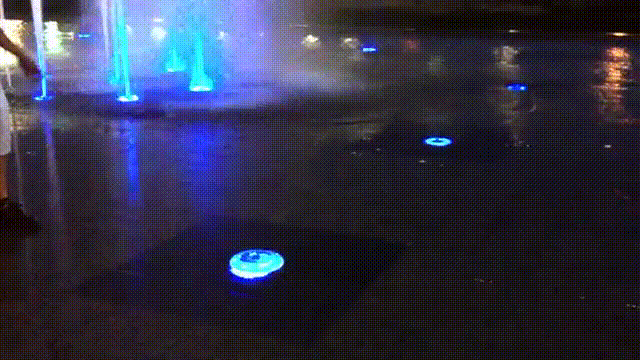
_______________
Yoan Capote Tear Duct (2001)
In Tear Duct (2001), he replaced the top of a drinking fountain with a stainless-steel mold of the face of a classmate who had to support herself through prostitution, a prevalent social problem in Cuba at the time. When viewers put a coin in the slot of the fountain, red wine spouts from her mouth. People drinking from the fountain are put physically and psychologically into the position of her customers, watching the wine and their saliva drain through her eyes.
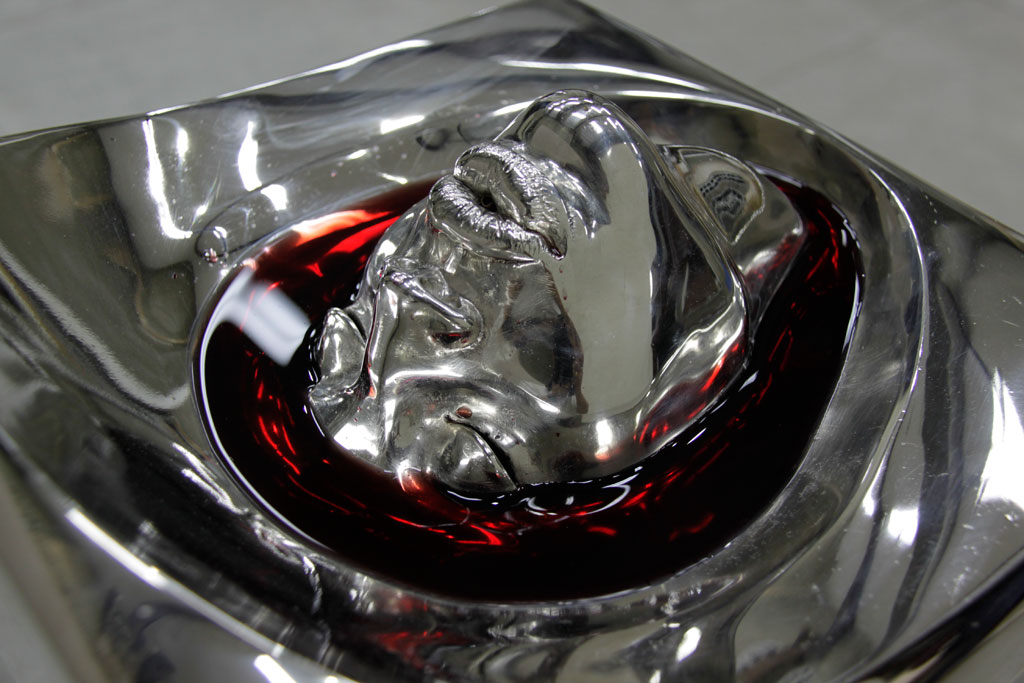


______________
Klaus Weber The Big Giving (2007)
In Klaus Weber’s work The Big Giving a group of male and female figures are cast rising out of, or simultaneously sinking into volcanic-looking mounds of rock made from industrial steel waste. Their heads and hands protrude from the stone and streams of water gush from a different body part on each figure, spouting from mouths, eyes, ears and armpits.
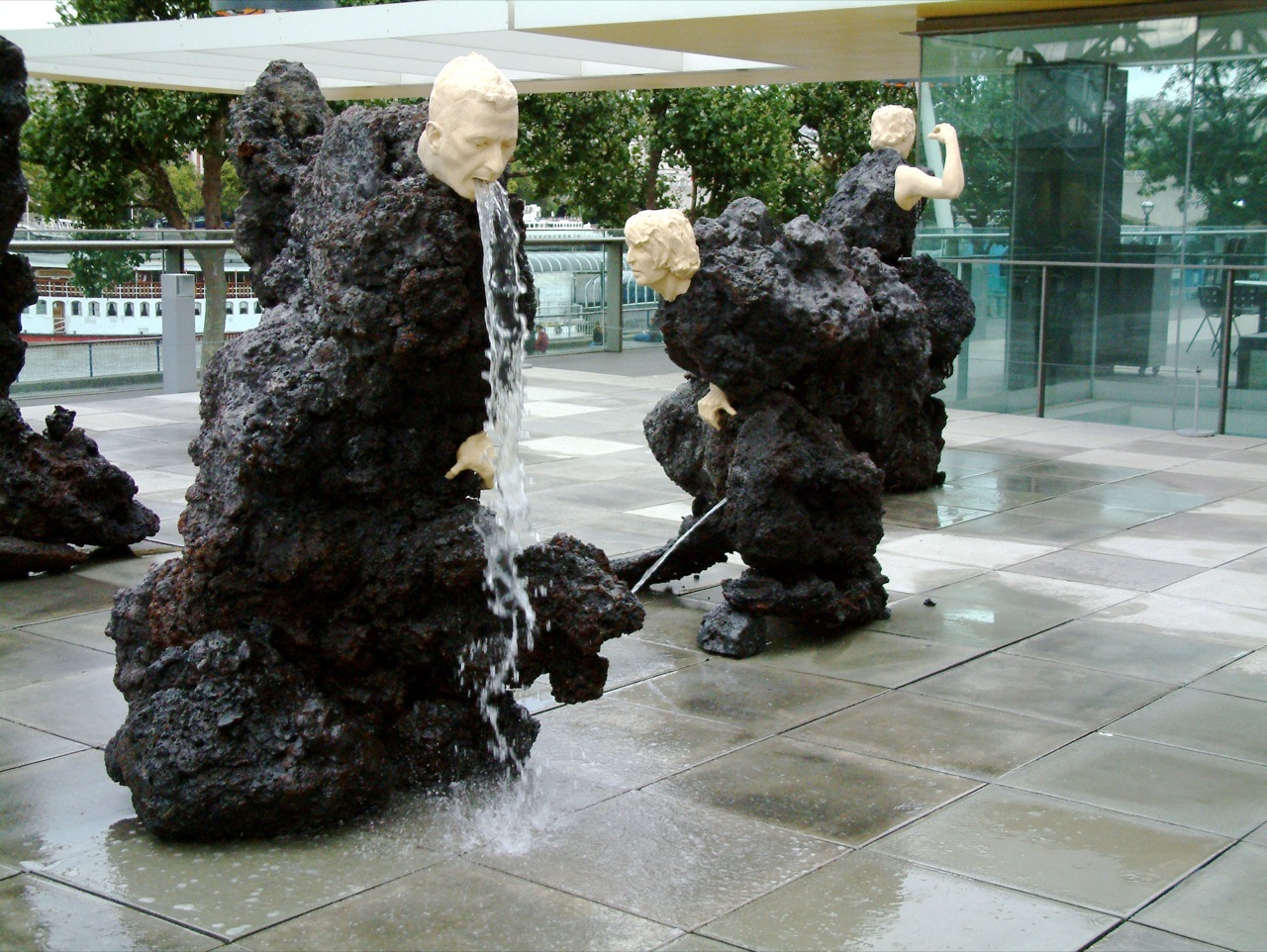

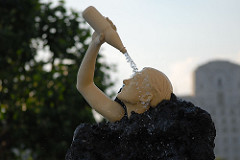
______________
Charles Ray Ink Line (1987)
Ink Line is a sculpture/drawing/fountain consisting of a stream of jet-black ink pouring from a dime-size hole in the ceiling into a dime-size hole in the floor. Initially Ink Line looks like a strand of yarn strung the height of the gallery, a pulsating Fred Sandback sculpture, a free-floating Barnett Newman zip, or a disembodied Sol LeWitt. Get close and you’ll realize the line is liquid, glimmering, the consistency of syrup, moving fairly fast, fluctuating slightly, and thinner at the bottom than at the top. The ink forms a weird climatological aura around itself, slightly changing the humidity of the room.
______________

______________
Bartosz and Malgorzata Szydlowska Fountain of the Future (2014)
A bright yellow statue of Vladimir Lenin answering a call of nature has been installed in Nowa Huta, the ‘ideal socialist town’ built on the edge of Krakow in the Stalinist era. Fountain of the Future, as the work has been dubbed by artists Bartosz Szydlowski and Malgorzata Szydlowska, references a statue of Lenin that once took pride of place in the district. The diminutive yellow version is a replica of a communist-era work which anti-regime activists tried to blow up on several occasions during the 1970s and 1980s.


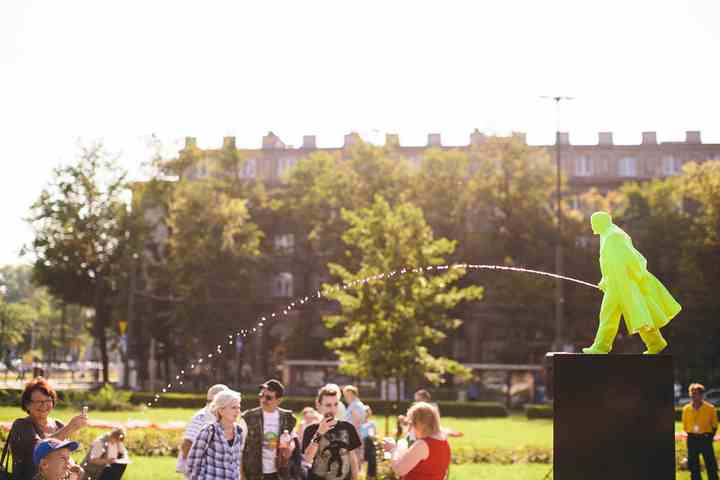
_____________
Joseph Havel Endless (2013)
Havel has created an “endless column” of books. Endless (2013), made from books cast in bronze and resin, emerges from the centerpiece of the Museum’s lawn, the Ballard Fountain. The column of books, cast from a stack of Sotheby’s auction catalogues among others, stands almost 20 feet high and gradually transitions from bronze to translucent resin.
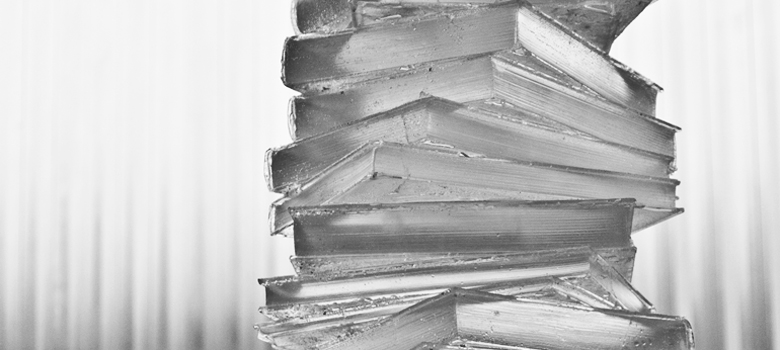

______________
Aldo Froese Fountain #5 (2010)
A waterflow is directed through the frame of a wheel barrel. As time passes, the water changes color and turns from clear to yellow, orange, red, brown and ends up as almost black.
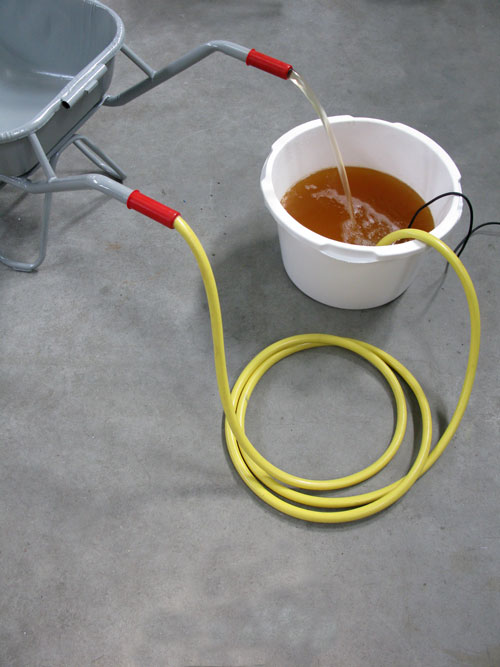
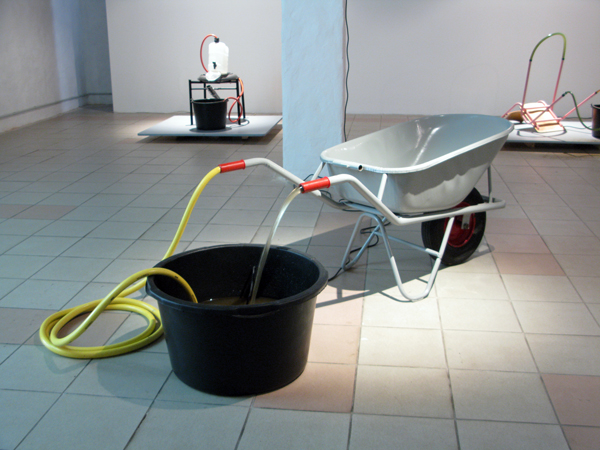

_______________
Bruce Nauman One Hundred Fish Fountain (2012)
The Nauman sculpture, one of the largest artworks the artist has ever made, is a functional fountain comprised of 97 bronze casts of fish that are suspended throughout the air that noisily shoot water out of their mouths into a large basin below, occasionally coming to a complete halt.
_______________
Andrew Salomone Vomiting Doll Punch Bowl Fountain (2015)

______________
Roman Signer Kayak with Fountain (2015)
And out on the terrace there was another bloody kayak – this one had been put on top of a fountain and had a hole put in it so it looked like it had sprung a leak! LOL. ART.


______________
Ice sculpture fountains
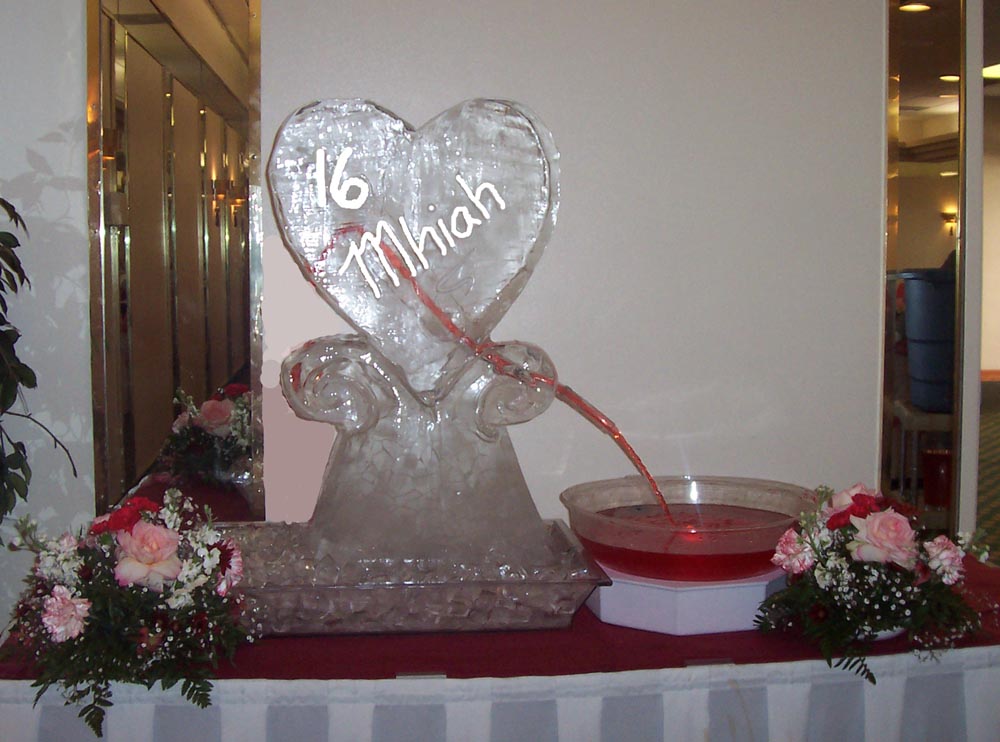

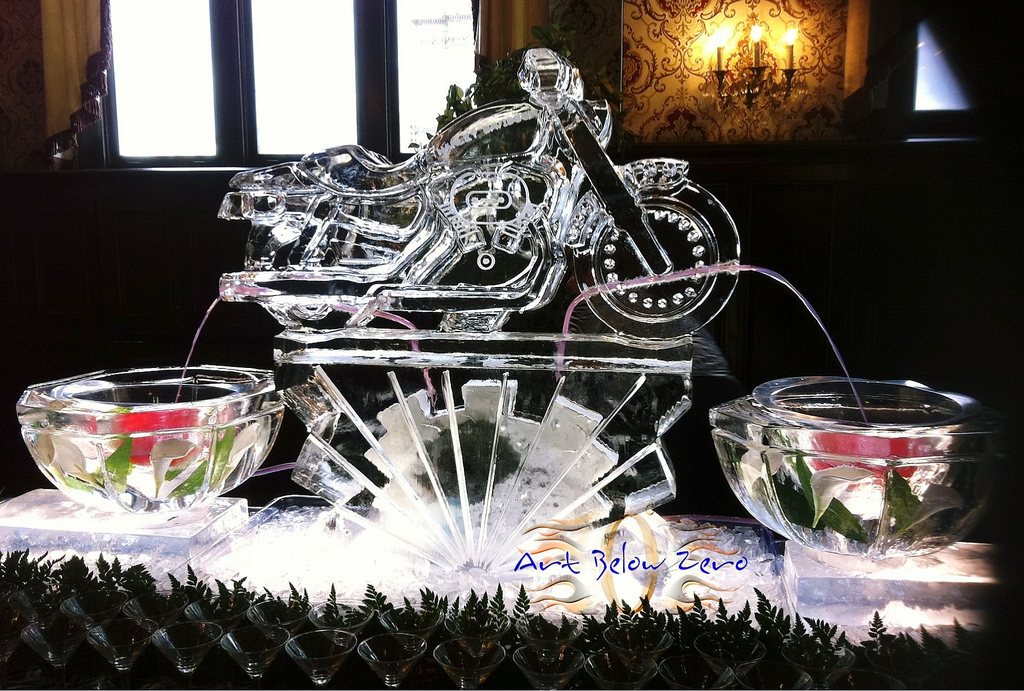

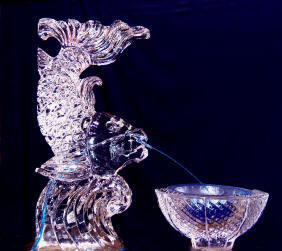
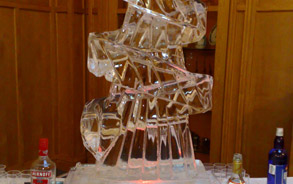
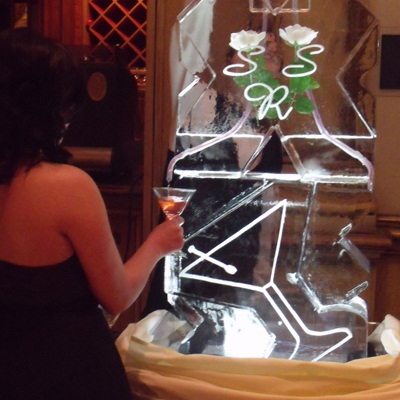
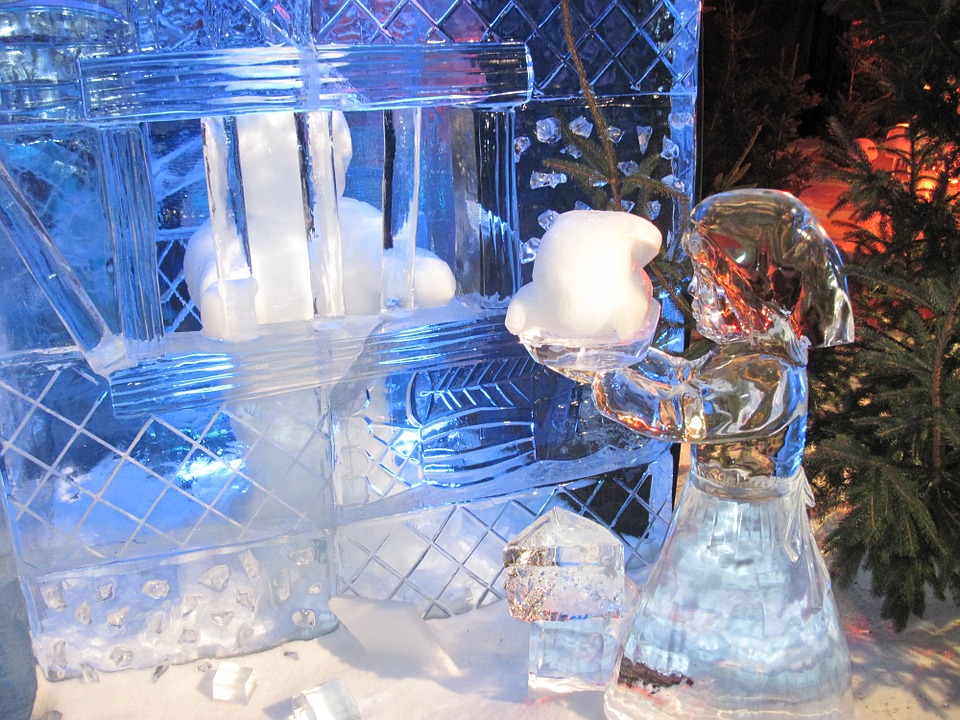
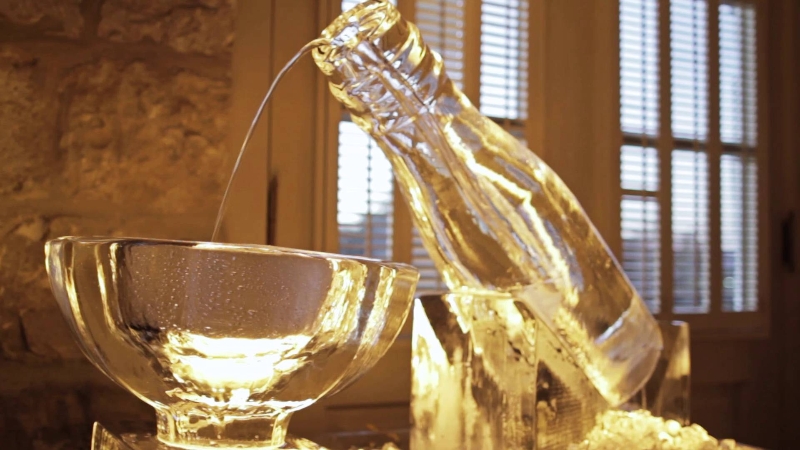
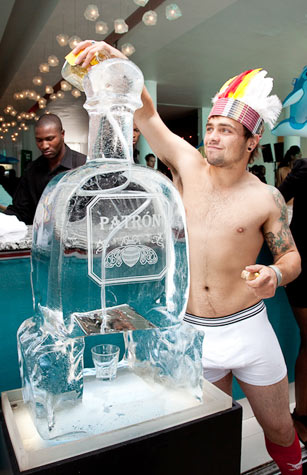

______________
Doug Aitken Fountain (earth fountain) (2013)
Fountain (Earth Fountain) (2012) is blatantly derivative of a more famous work. In a large rectangular vitrine the letters “A-R-T”, built from Lucite, ooze smooth creamy mud resembling milk chocolate. It immediately recalls Robert Rauschenberg’s Mud Muse (1971)—itself a large rectangular vat filled with mud rigged to bubble and sputter like lava. The use of the word “ART” here merely underlines one obvious subtext of Rauschenberg’s piece: that something as ubiquitous and abject as mud could so effectively be corralled into the realm of art. This makes Aitken’s rather polished version more like CliffsNotes for a canonical work than anything else.
_______________
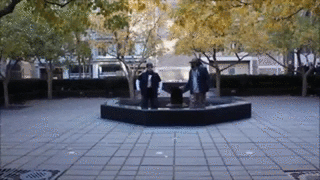
_______________
Tue Greenfort Crystal Fountain (2014)

_______________
Santo Tolone Fontana Angelica (2014)
Santo Tolone’s immersive “Fontana Angelica” is a working fountain based on a design by early 20th century architect Piero Portaluppi. As the name hints, the original fountain would have been decorated with angels, but Tolone’s version is stripped down to just the plumbing of the fountain. What remains is a simple, structural beauty. It’s also an exhibition within the exhibition: Tolone curated a display of coins made by other artists in the pool, including works by John Baldessari, Tim Foxon, Nick Fusaro, Ryan Gander, Micah Lexier, Jonathan Monk, M/M, Alek O, Michelangelo Pistoletto, Wilfredo Prieto, Rob Pruitt, Yann Sérandour, Jack Strange, Santo Tolone, Amalia Ulman, and Anne de Vries.
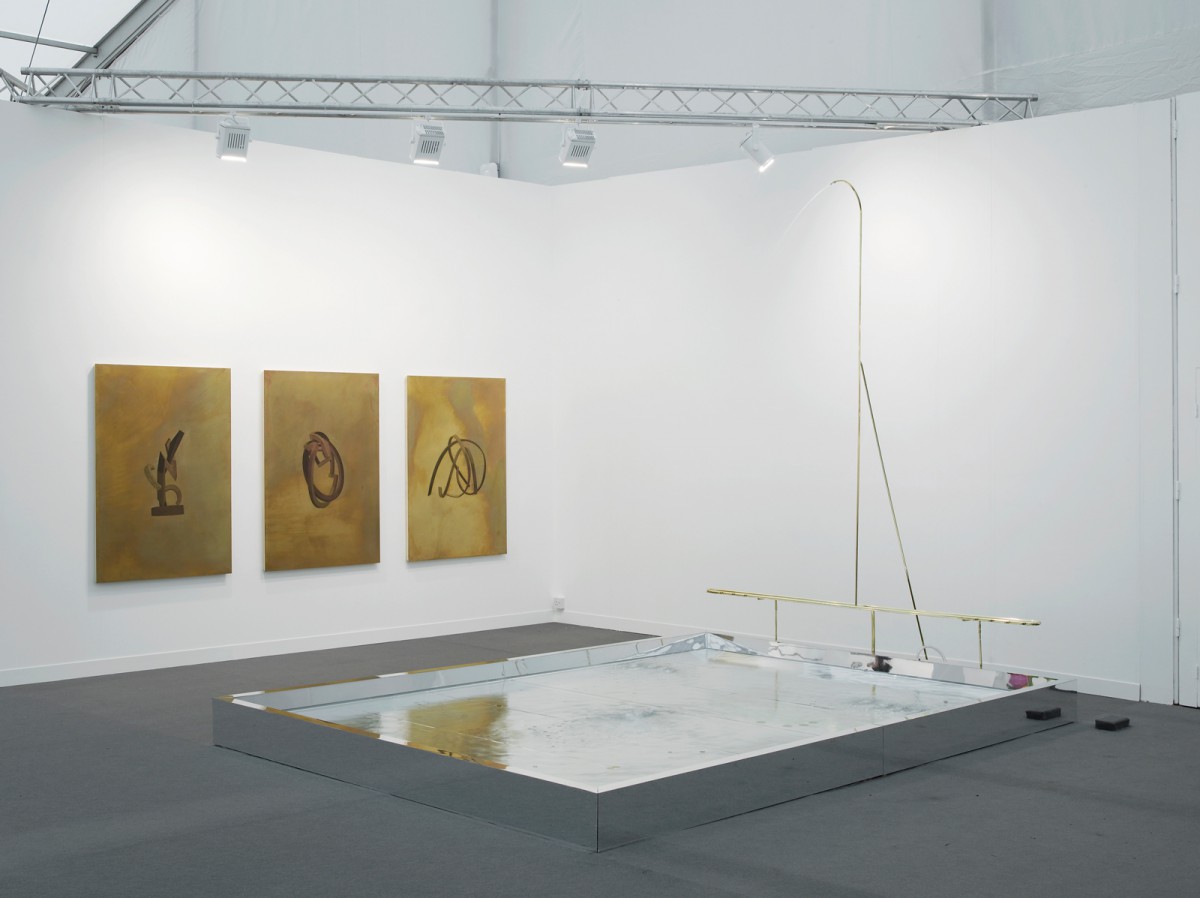
______________
Taro Shinoda Model of Oblivion (2006)
Inside the screens is a small room containing “Model of Oblivion,” in which a visceral red liquid is clinically pumped across “white cliffs,” creating a vision as sinewy as human muscles on a white table. Explaining his approach, Shinoda says: “In my mind, waterfalls are connected to oblivion. When I stare at a waterfall, I go into a daze and forget reality. But the essence of myself is always there, even when I forget everything. I tried to express that here in an abstract sense.”

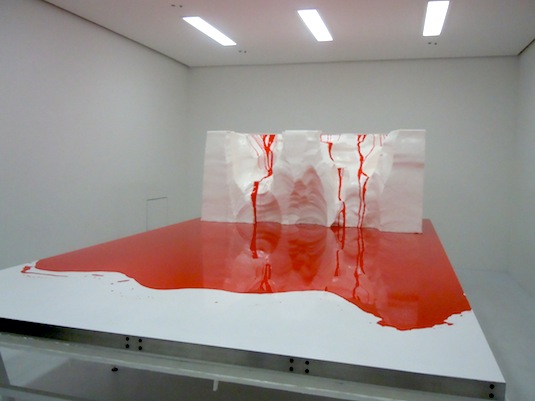
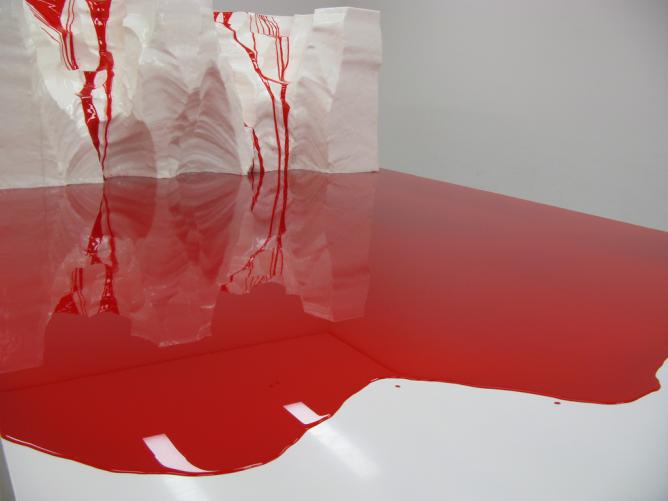
______________
Daniel Wurtzel Feather Fountain (2010)
Feathers, mirrors, fiberglass and air
______________
Sam Durant Proposal for Public Fountain (2013)
Proposal for Public Fountain centres on a fountain sculpted from black marble – a prototype for a larger installation in a public setting – together with a series of related graphite drawings. The structure features a reproduction of an armoured water cannon, which sprays a jet of water onto a hooded figure bearing an anarchist flag. Its note of polemic is a defining aspect of Durant’s art. Poised between detached commentary and acerbic critique, it recasts a contemporary episode of state authoritarianism in the ‘stately’ aesthetics of public stonework.
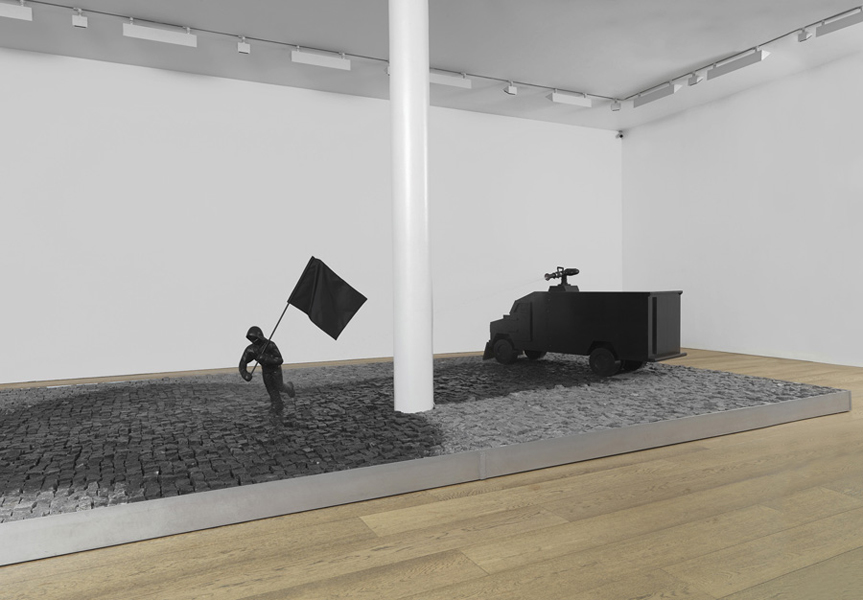
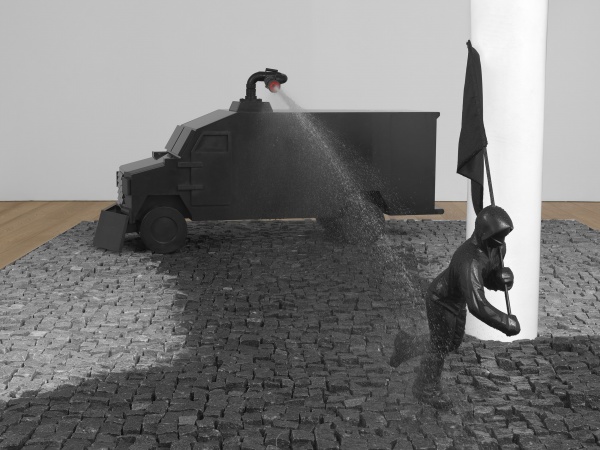

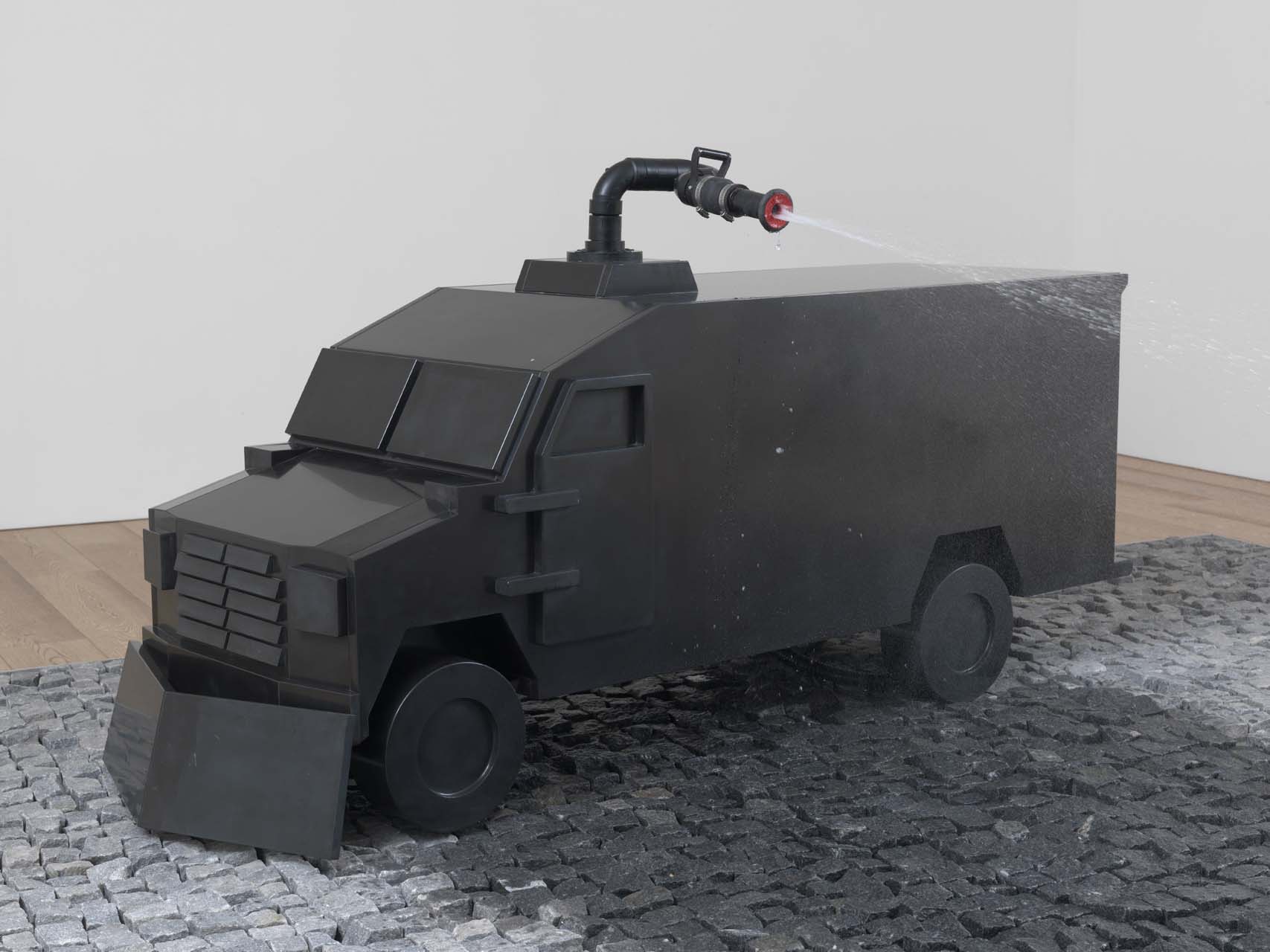
_______________
Slavs and Tatars Reverse Joy (2012)

_______________

______________
Olafur Eliasson Big Bang Fountain (2014)
Every few seconds it is illuminated by photoflash lightning. The image of the bright dancing water leaves a ghostly impression in the mind’s eye. Keep watching the flashes of silver water and you see blue impossible forms in the afterglow.
_______________
Robert Gober The Heart Is Not a Metaphor (detail)
Gober’s chapel in honor of September 11, 2001, originally shown at Matthew Marks in 2005, is one of the culminating rooms in the exhibition. At the front of the chapel are two doors through which one can barely make out a naked pair of legs submerged in a running bathtub. The child peeks through the cracked door and sees something it cannot understand—something it is, perhaps, not supposed to see.


______________
Eli Hansen and Oscar Tuazon Huh (2012)
Toilet, stell, water, 68 X 36 1/4 X 47 1/4 inches
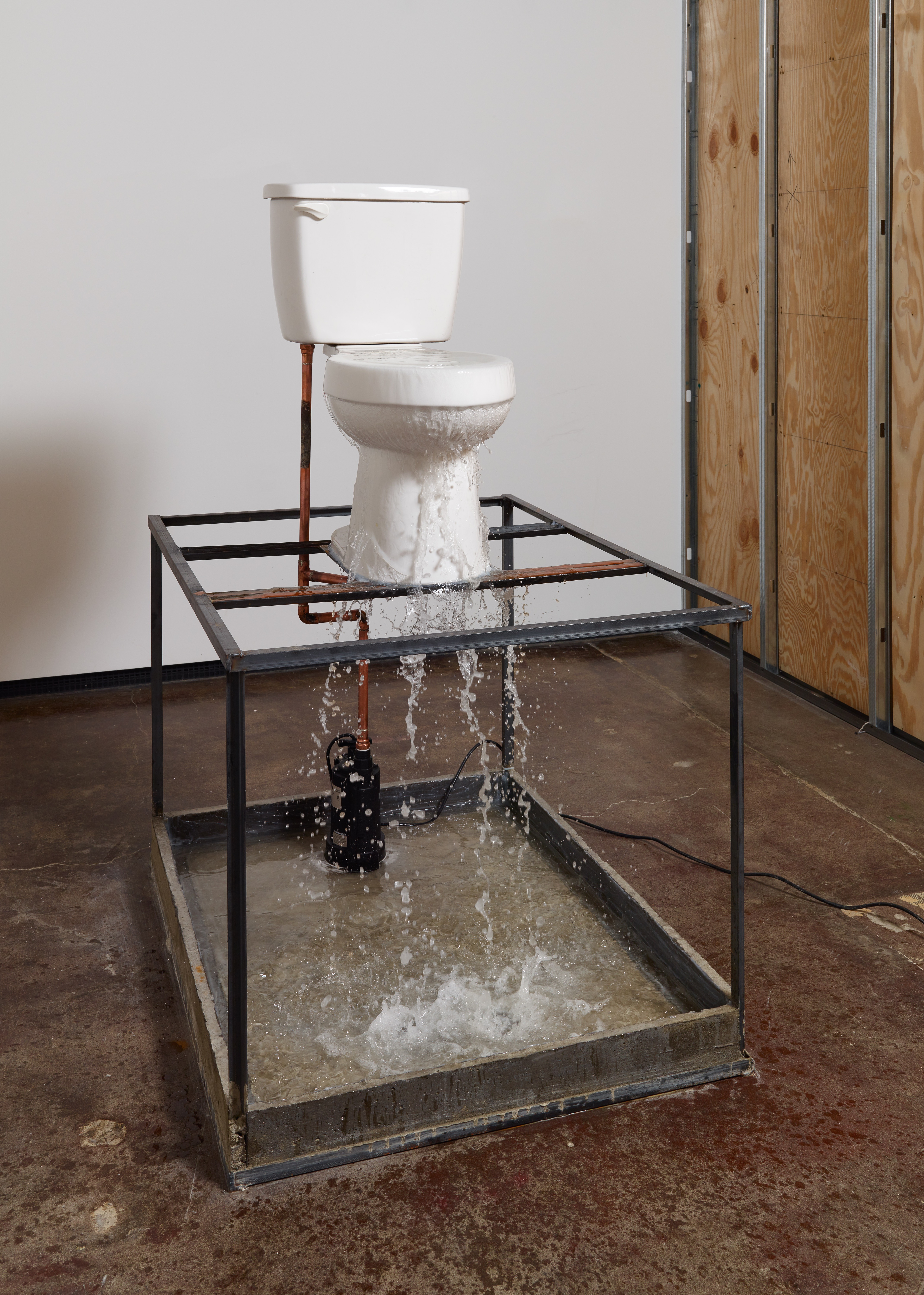
_______________
Unknown Decapitated Head Drinking Fountain
_______________
Vincent Houze Interactive Fountain Mapping (2016)
The result of a collaboration with AV&C;, an experiment where one can control a simulated liquid flow and watch it splash against a geometric sculpture. It was premiered during SEGD Xlab conference 2015 in New York. As in previous experiments the liquid simulation is driven by the nVidia library Physx FleX that I implemented in TouchDesigner, which is used for the mapping and overall set up.
________________

_______________
Dan Flavin proposed fountain in memory of Pablo Picasso (1974)
Black ballpoint pen on white looseleaf notebook paper

______________
Thiago Rocha Pitta Inverted fountain (2003)
Thiago Rocha Pitta is best known for his “collaborations” with nature, outdoor interventions that harness its forces, processes, and beauty. Here he has created an inverted fountain by the side of a lake.
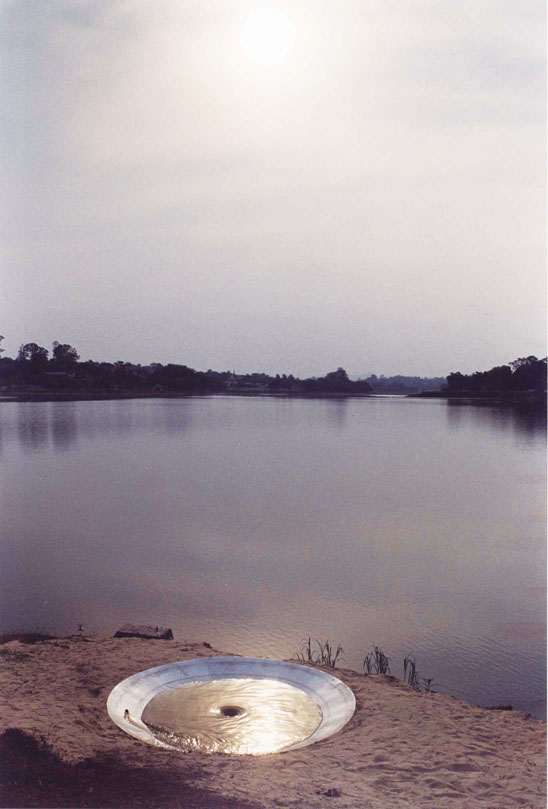
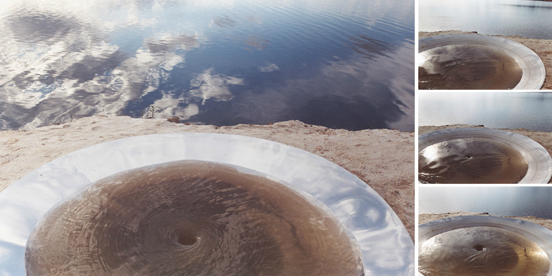
_____________
Hany Armanious Fountain (2012)
Fountain (2012) is based on an anatomical model of the inner ear and a weathered outdoor table. Meticulously carved in Opal Bianca marble at ten times the model’s original size, the ear is a complex and mysterious form, containing transparent resin casts of the ear drum and cochlear. Instead of running water Fountain evokes the idea of water, through its references to the fluid of the ear canal, the undulating contours of the marble, and the translucent resin shapes that sit like droplets of liquid trapped inside the ear.
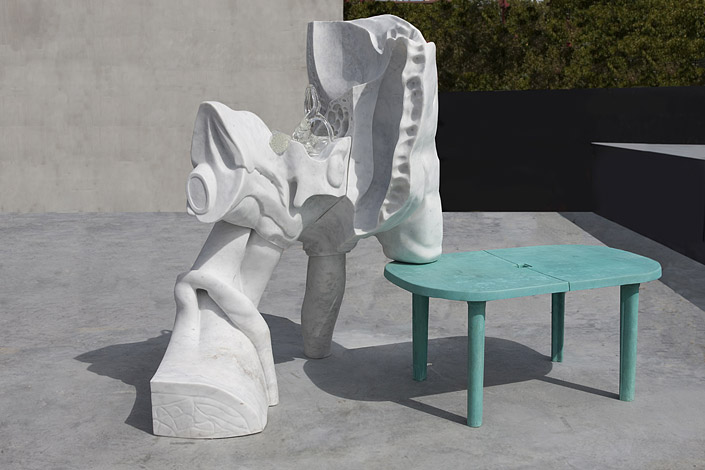
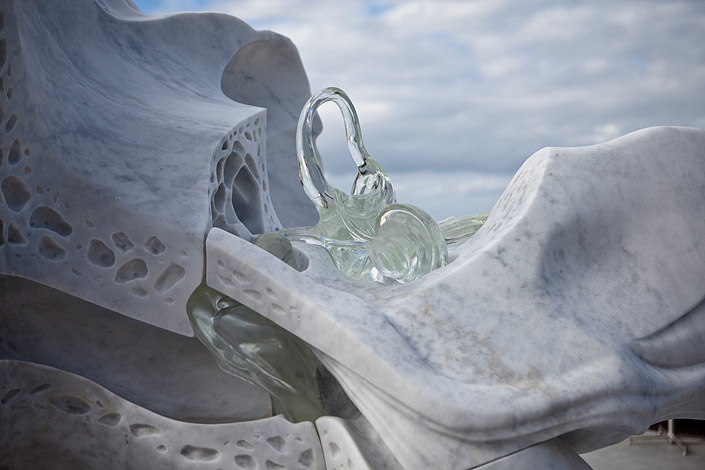

______________
The world largest dancing fountains, Burj Khalifa
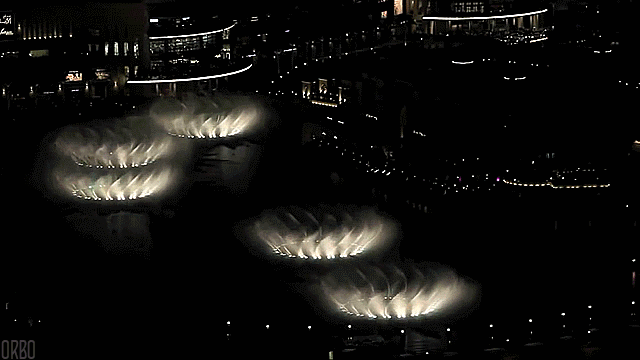
______________

____________
Denis Adrien Debouvrie Jeanneke Pis (1987)
Jeanneke Pis is a modern fountain and statue in Brussels, which was intended to form a counterpoint to the city’s Manneken Pis, south of the Grand Place. It was commissioned by Denis-Adrien Debouvrie in 1985 and erected in 1987. The half-metre-high statue of blue-grey limestone depicts a little girl with her hair in short pigtails, squatting and urinating. It is located on the east side of the Impasse de la Fidélité / Getrouwheidsgang (Fidelity Alley), a narrow cul-de-sac some 30 metres long leading northwards off the restaurant-packed Rue des Bouchers / Beenhouwersstraat. The sculpture is now protected by iron bars from vandalism.
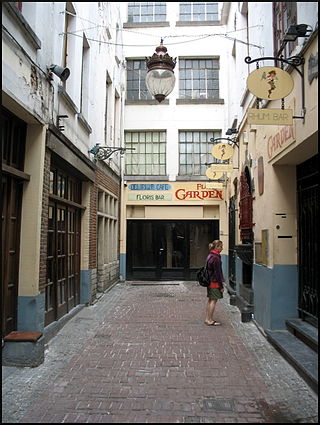
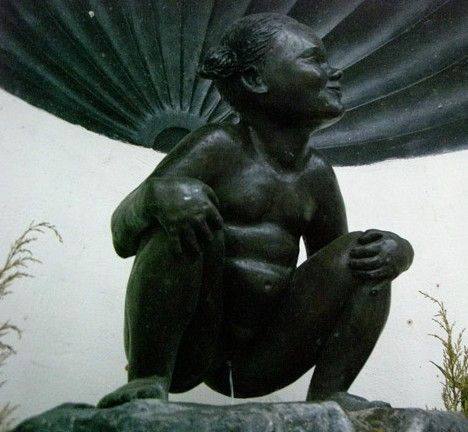
_____________
José Lerma Fountain (2014)
‘A Critical Analysis of Central Banks and Fractional-Reserve Banking from Austrian School Perspective,’ an installation that takes form in the shape of a 10% fraction of a circular fountain which is flanked by mirrored walls. An essay by Spanish economist Jesus Huerta de Soto, from the Austrian School, serves as the inspiration for the work and title. The percentage reflects the minimum requirement of liquid assets the United States’ financial institutions are required to hold by law in order to operate. ‘A Critical Analysis…’ presents a contrast to the interaction the portraits have with each others’ reflections, instead of borrowing from the impressions of each piece to build on the final compositions, the fountain completes itself through the illusion of a whole in the mirrors, creating a kaleidoscopic effect. The installation is activated through performance in which water sounds are made by participants standing within the structure as sculptural elements of the fountain itself.
*
p.s. Hey. I seem to have arrived back in Paris, and I’m about to take a nap, and I’ll see you tomorrow.




 Now available in North America
Now available in North America 
Fountains of Wayne
Hey Dennis – Great collection of fountains here. For whatever reason, the Charles Ray particularly hit me, along with the boy-and-frog, sand fountain, Nauman, and the inverted fountain.
Been reading Roche’s “Compact” recently and loving it. Pretty sure I first heard about it here, so thanks for that. Are you a fan of “Moravagine”? Been reading that as well, knocked out by parts of it but also surprised to find certain sections less than exciting.
Hope you shake off the jet lag quickly. Let me know once you’re feeling human. Love to chat via Skype about my Paris trip.
I would totally drink from the severed head fountain. That blood fountain is pretty fine as well.
Ken Atchley built some nice pieces and installations with fountains, but I can’t find much online documentation:
https://en.wikipedia.org/wiki/Kenneth_Atchley
Hope the flight was ok, packed with entertaining bad movies, and you shake the jet lag soon.
Bill
Hi!!
Welcome back!! Back here and back home! How are you? Jet lag on a scale of 1 to 10? I hope you have a few days now to just rest up and process the happenings of these past 1,5 weeks.
Oh, it’s very reassuring to hear that you also have some weirdness going on with your wisdom teeth and they’re perfectly okay! I really don’t feel like fucking mine up ’til everything’s alright with it.
I think my only share-worthy weekend experience is that I got some new SCAB submissions I adore – the fourth issue is closing in on what I’ve had in mind for SCAB from the very beginning and I’m so excited to share it! Less than a month now, if all goes as planned.
Have a great, great week, Dennis and see you on Friday!!
I hope your flight went well and your jet lag isn’t too oppressive in the next day or so.
I’m now listening to a rare dub remix of the Cars’ “Hello Again.” This sounds like a long-lost outtake from the Art of Npise’s first album, with those staccato samples due to the technology of the time.
Hi again Dennis! It’s Quinn here, we had a brief correspondence last fall. How are you lately? What’s new?
Sadly I had to leave Berlin (I could not find a job, and was also partying too much) so I’m not sure when we’ll get the chance to get coffee, but I want to express again that I’d love to meet you someday. I brought home a copy of Frisk that bears your signature–it belongs to Francois Choquet, who became a close friend of mine. In turn, he has my copy of Veronica by Mary Gaitskill…Francois and I had a lot of great conversations about you, and also about Jean Cocteau.
Wanted to ask you some writerly advice…what are your thoughts about MFA programs? I am waiting to hear back from 7 programs, and last year I got rejected from 8 programs. I applied for fiction at pretty competitive places like Iowa and Cornell–what do you think? If I get rejected, what are some suggestions for avoiding discouragement & keeping motivated to write?
Thanks in advance for any advice you can offer. Hope you’re having a great 2019 so far 🙂
Hey Dennis!
How was the trip to the states? I saw that you got a Bookworm for PGL, which is totally incredible. That’s my favorite podcast for sure. Congratulations on the screenings! Sorry you’ve gotta deal with jet lag so often haha.
Oh, funny thing btw. Peggy Ahwesh keeps telling us in the film class to try imitating scenes from established movies, to see if we learn something from it I guess. he suggested it I think right after I listened to your Lincoln center interview thing. And you talked about that “Reflections in a Golden Eye” ending so highly, and I ended up watching the movie and really loving it (the ending particularly… the rest was really weird, very chaotic and messy in a way that was interesting, if incoherent), so I decided to recreate the scene scene for class. The theme was also SLEEP and VISITATIONS, so it worked in the context. I spliced it with another scene from earlier in the movie to add more than two shots to it, and try and do something different with the editing (Which I may cut all together, if it ruins the pacing). Shot-wise, it’s a pretty pale comparison, but was still fun to try and get the costumes period specific and figure out and effective way to re-structure that final shot. Now I just have to figure out how to make it gold haha.
I also noticed Ann Lauterbach talks about trying imitation all the time. Have you ever imitated work you have a strong connection to as artistic exercises? I know you use them as models sometimes, but I feel like imitation is a different thing entirely. I only ask cuz I’ve always thought, for whatever reason, it’s something to avoid, but now I’m having two teacher who I majorly respect telling me to do it.
Good luck with the travel hangover. Have a great week!